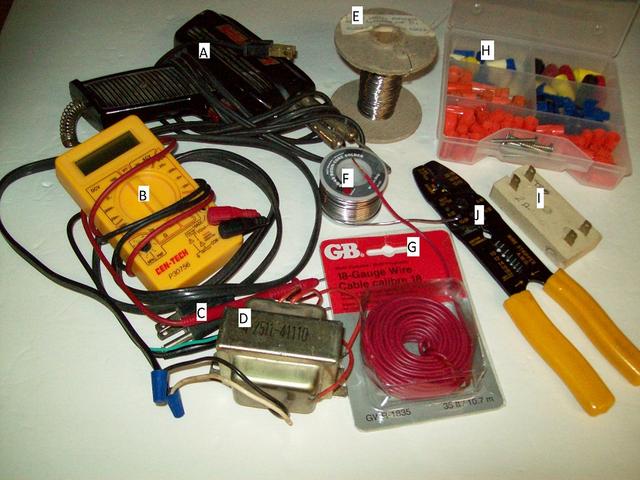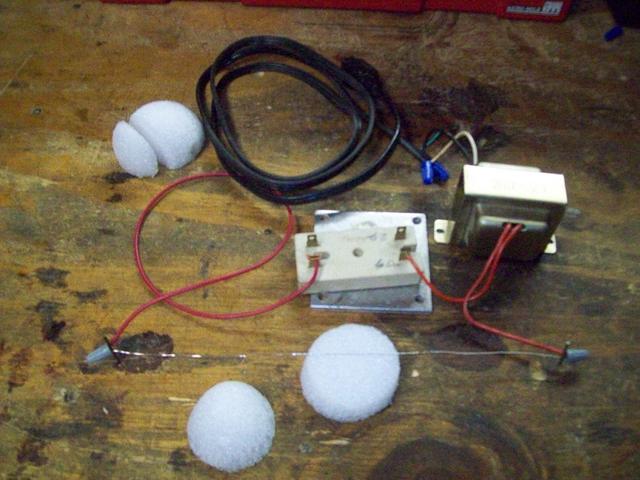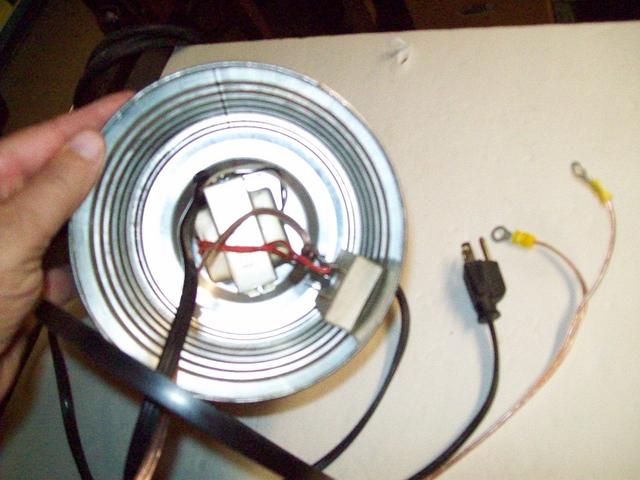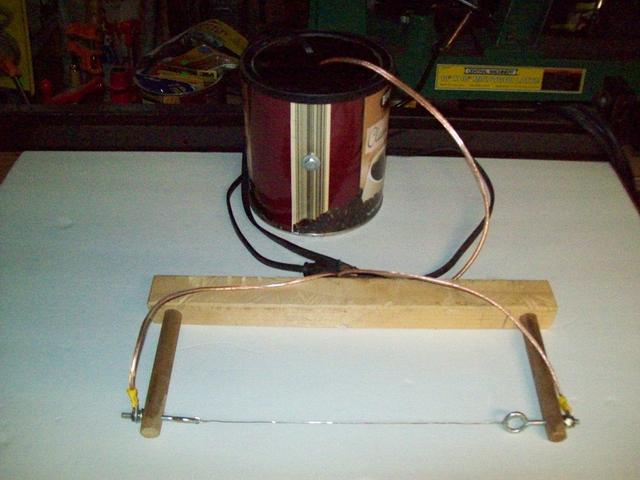Make your own styro-foam wire cutter. Posted by rocky on Sep 02, 2010
Warning, danger, danger... Proceed at substantial risk! Life threatening electrical levels are used in this project which can present the danger of electrocution.... If you have no experience in electrical wiring find someone who does to assist you! (or drop this project!)
Also, hot wire cutting of many plastics releases noxious and in some cases deadly fumes... use outside or with more than adequate ventilation. The wire and resistor get hot enough to burn you!
Still sure you want to proceed AT YOUR OWN RISK? You can cut foam with scissors you know... just don't run with them.
The vital calculation!
You must limit the amperage to the Ni-chrome wire with the wire wound resistor or you run the risk of blowing the house fuse. (or circuit breaker) You may also ruin your transformer with excessive current demands. Resistor means it resists current flow which generates heat. Both the Ni-chrome wire and the resistor will get hot.
The trick is to get enough amperage to make your Ni-chrome wire hot without damaging any of the components. (You don't need to get it glowing red like a toaster!) I suggest 2-3 amps as sufficient.
So... you should use ohms law to calculate amperage like this:
My resistance for the Ni-chrome wire is 1.3 ohms per foot. (yours may vary)
My wire wound resister total resistance is 6 ohms. (using one side, mine has two windings, 6 and 2 ohms, yours may be different)
My transformer (as measured by a multimeter) output is 17.8 volts. (surprised me, the surplus store item was advertised as a 12 volt transformer!)
Amperage = volts divided by total resistance...
3. ohms + 6 ohms = 7.3 ohms divided into 17.8 volts = 2.438 amperes current available.
(Ni-chrome) + (resistor) = 7.3 ohms
Items you may need:

A) Soldering gun (or iron)
B) A multimeter
C) Household electric plug with attached wire
D) Transformer, any rated at 3 amps or more delivering from 5-12 volts
E) Ni-chrome wire (Nickel & chrome composition which heats up red hot without breaking)
F) Rosin core Solder
G) Connecting wire
H) Electrical connectors
I) Ceramic case wire wound resistor
J) Wire stripper tool
Sources of supply: Surplus or retail electronics stores, hardware stores, internet venders, etc.
Yet another warning for the truly dim...
This circuit has no on/off switch. I you leave it plugged in and unattended you may burn your house down. If you do you cannot move in with me.
Connecting it all together... the 'bread-boarded' circuit with due mischief done to a styro egg.

The power cord is connected to the primary coil of the transformer. One of the transformer secondary outputs (the low voltage side) is wired/soldered to the wire-wound resistor. The other end of the resistor is soldered and wired directly to the Ni-chrome wire. The other transformer secondary output is wired to the other end of the Ni-chrome completing this simple circuit. See the metal plate beneath the resistor? That is to help dissipate the heat so it does not burn my pristine workbench top. Also, note that I have simply stretched the Ni-chrome between two nails for this 'smoke' test... If all goes well up to this point you are ready for the next step, housing the circuit and fabrication of a 'stretcher/holder'.
Housing the circuit... I advise metal to dissipate heat. Do make sure good wiring practices are followed so that any 'hot' wires are insulated and kept away from the housing! This is a coffee can which works just fine. The object is to keep any potentially harmful voltages well away from the potential users. Two longer wire leads were added from the transformer and resister so as to allow remote connection to a handle of sorts.


As to the 'stretcher/holder' thingee... hopefully this picture of a quite simple contrivance is worth a thousand words. The object is to stretch the Ni-chrome wire between two points maintaining suitable space and electrical separation between those points.
Many design modifications could be used... you might for instance prefer to stretch your wire vertically with a different type of structure simulating a band-saw.
Work safe and best of good Luck! - rocky
Also, hot wire cutting of many plastics releases noxious and in some cases deadly fumes... use outside or with more than adequate ventilation. The wire and resistor get hot enough to burn you!
Still sure you want to proceed AT YOUR OWN RISK? You can cut foam with scissors you know... just don't run with them.
The vital calculation!
You must limit the amperage to the Ni-chrome wire with the wire wound resistor or you run the risk of blowing the house fuse. (or circuit breaker) You may also ruin your transformer with excessive current demands. Resistor means it resists current flow which generates heat. Both the Ni-chrome wire and the resistor will get hot.
The trick is to get enough amperage to make your Ni-chrome wire hot without damaging any of the components. (You don't need to get it glowing red like a toaster!) I suggest 2-3 amps as sufficient.
So... you should use ohms law to calculate amperage like this:
My resistance for the Ni-chrome wire is 1.3 ohms per foot. (yours may vary)
My wire wound resister total resistance is 6 ohms. (using one side, mine has two windings, 6 and 2 ohms, yours may be different)
My transformer (as measured by a multimeter) output is 17.8 volts. (surprised me, the surplus store item was advertised as a 12 volt transformer!)
Amperage = volts divided by total resistance...
3. ohms + 6 ohms = 7.3 ohms divided into 17.8 volts = 2.438 amperes current available.
(Ni-chrome) + (resistor) = 7.3 ohms
Items you may need:

A) Soldering gun (or iron)
B) A multimeter
C) Household electric plug with attached wire
D) Transformer, any rated at 3 amps or more delivering from 5-12 volts
E) Ni-chrome wire (Nickel & chrome composition which heats up red hot without breaking)
F) Rosin core Solder
G) Connecting wire
H) Electrical connectors
I) Ceramic case wire wound resistor
J) Wire stripper tool
Sources of supply: Surplus or retail electronics stores, hardware stores, internet venders, etc.
Yet another warning for the truly dim...
This circuit has no on/off switch. I you leave it plugged in and unattended you may burn your house down. If you do you cannot move in with me.
Connecting it all together... the 'bread-boarded' circuit with due mischief done to a styro egg.

The power cord is connected to the primary coil of the transformer. One of the transformer secondary outputs (the low voltage side) is wired/soldered to the wire-wound resistor. The other end of the resistor is soldered and wired directly to the Ni-chrome wire. The other transformer secondary output is wired to the other end of the Ni-chrome completing this simple circuit. See the metal plate beneath the resistor? That is to help dissipate the heat so it does not burn my pristine workbench top. Also, note that I have simply stretched the Ni-chrome between two nails for this 'smoke' test... If all goes well up to this point you are ready for the next step, housing the circuit and fabrication of a 'stretcher/holder'.
Housing the circuit... I advise metal to dissipate heat. Do make sure good wiring practices are followed so that any 'hot' wires are insulated and kept away from the housing! This is a coffee can which works just fine. The object is to keep any potentially harmful voltages well away from the potential users. Two longer wire leads were added from the transformer and resister so as to allow remote connection to a handle of sorts.


As to the 'stretcher/holder' thingee... hopefully this picture of a quite simple contrivance is worth a thousand words. The object is to stretch the Ni-chrome wire between two points maintaining suitable space and electrical separation between those points.
Many design modifications could be used... you might for instance prefer to stretch your wire vertically with a different type of structure simulating a band-saw.
Work safe and best of good Luck! - rocky
Re: Make your own styro-foam wire cutter. Posted by Billy D. Fuller on Sep 02, 2010
Excellent but I still don't think I can do it.................... I have stack of papers of instructions on how to do it......even watched a video. I think if I watched someone in person make one I might be able to get it.......... but for now I just bought one. I would however like a better one at some point.
Billy D.
Billy D.
Re: Make your own styro-foam wire cutter. Posted by Billy D. Fuller on Sep 02, 2010
I forgot Rocky THANK YOU so much for sharing that information with us.
Billy D.
Billy D.
Re: Make your own styro-foam wire cutter. Posted by rocky on Sep 02, 2010
You are most welcome. If you are not comfortable working with electricity I would be the first to advise caution... buying a unit is safer and saves time which might be better spent on your real goal; making the puppets. I felt the need to put this information out because the items I saw in the craft stores worked off a short-lived battery which could get cost prohibitive for frequent use. Think of this design as the industrial strength version. The information I found on the web was either self-serving or incomplete. I was disappointed in this project when a test revealed that it cut Styrofoam quite nicely with a smooth edge but, it did not cut the poly-foam (both green and white) used by the folks on this site. I found that when using the 2 ohm side of my resister (increasing the amperage to approximately 6 amps.) the wire got hot enough to cut the poly-foam in a similar fashion. Again, let caution prevail... insure that your step-down transformer can handle that amperage! (Re-read that part about adequate ventilation!) I read, then confirmed in the shop, that such foams can be cut with the BACK (no teeth) of a band-saw blade which raises interesting possibilities for cutting foam as well. Ya just gotta wonder if a vibrating wire would accomplish the same thing. Or, perhaps a spinning disk...
Regards rocky
Regards rocky
Re: Make your own styro-foam wire cutter. Posted by Billy D. Fuller on Sep 02, 2010
Rocky I hope you don't mind........... I put your hot wire cutter directions in a PDF file so others can print a copy of it. I put your user name Rocky on it. If I missed anything please let me know and I'll change it................ here is the link
PDF removed
Billy d.
PDF removed
Billy d.
Re: Make your own styro-foam wire cutter. Posted by StiqPuppet Productions on Sep 03, 2010
Thanks for sharing this idea. 
Daryl H.

Daryl H.
Re: Make your own styro-foam wire cutter. Posted by rocky on Sep 03, 2010
As to the conversion to PDF, no problem. Wasn't the promise of the internet the free exchange of ideas and knowledge? Quite awful pixilation of the pictures though. I think clear photos are necessary so advise users to 'click' on the gallery photos above to get a clear view. I did try to upload the completed project as a PDF however, the resulting file was 80 megabytes in size causing upload problems due to that large size. Invaluable Shawn helped sort that out!(The pictures were at least half of an 8-1/2 X 11 page in size, lotsa bytes!) I appreciate the 'attaboys' from you and Daryl! The project has had over 50 views to date which indicates wide interest to me... quite flattering. On to the next project(s) I spotted three wayang golek puppets at the local thrift store yesterday and today is half price day... hope to scoop them up. Purchased several vent figures the same way. Also, want to start drafting plans for one of the dancing dis-assembling skeleton marionettes... my spin on it will be to make an alien skeleton. Regards, rocky
Re: Make your own styro-foam wire cutter. Posted by Billy D. Fuller on Sep 03, 2010
I'll try and fix the pictures.................... When I saved them to my computer they were real small they looked OK in the original document but guess it changed during the transfer to PDF. I lost some of the picture quality during the conversion. I'll see what I can do to fix that. " SORRY "
PDF removed
PDF removed
Re: Make your own styro-foam wire cutter. Posted by rocky on Sep 03, 2010
You may care to proofread it as well... Some words have lost letters. I don't care to take credit for the poor spelling. Regards, rocky
Re: Make your own styro-foam wire cutter. Posted by Billy D. Fuller on Sep 03, 2010
Posted by: rocky on Sep 03, 2010
You may care to proofread it as well... Some words have lost letters. I don't care to take credit for the poor spelling. Regards, rocky
Rocky I just copy and pasted it to a word document................... I'll just delete it and let folks get there information here. Sorry for any inconvenience. Just trying to help.
BD
Loading
No More Post
Error
Loading